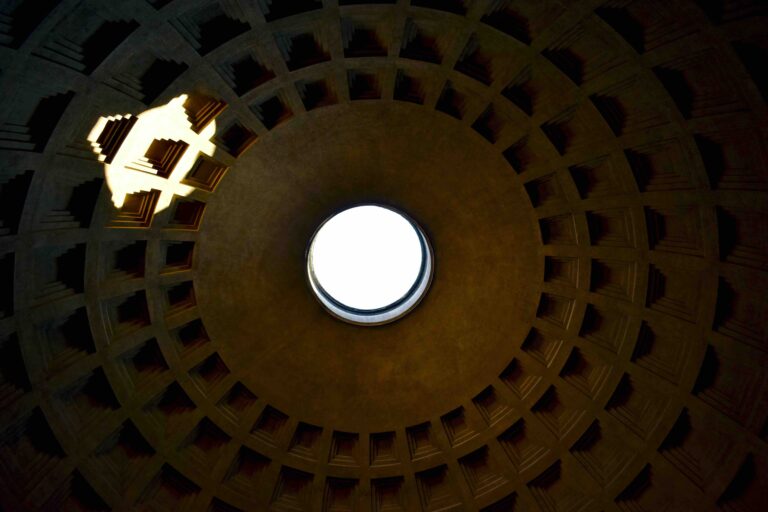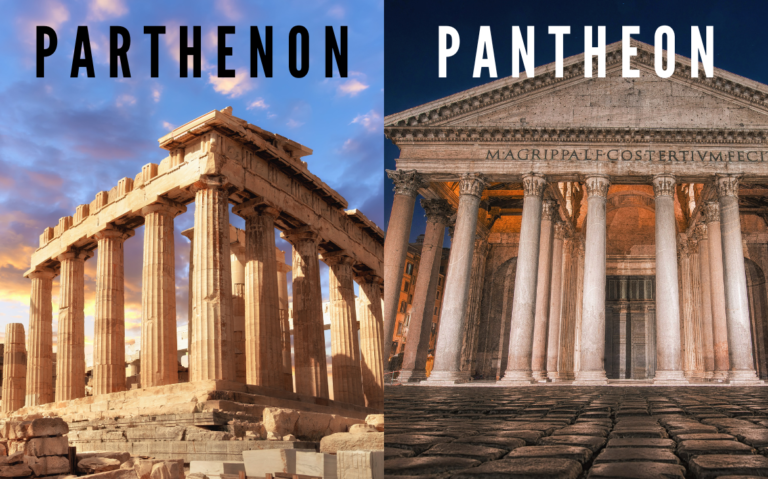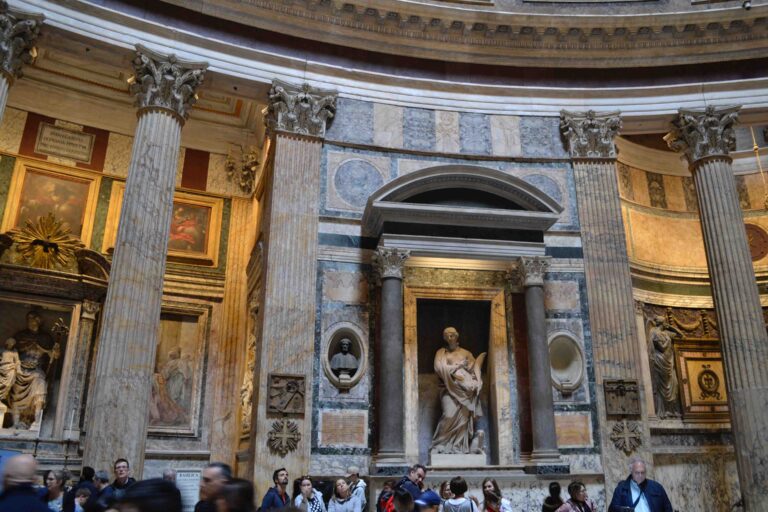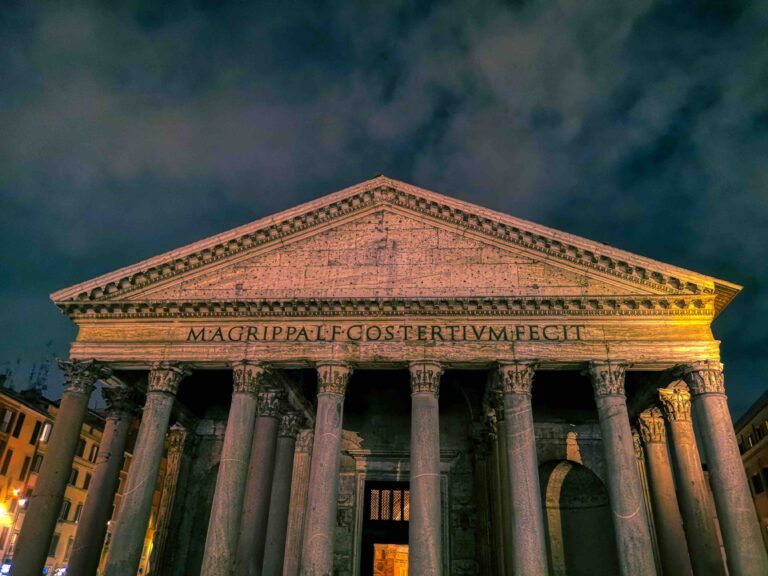If you could walk through a time machine and stand face-to-face with the Roman Empire at its peak, what would you see? For many, that feeling is captured in a single, breathtaking moment inside the Pantheon in Rome. Of all the ancient structures that still stand, this one remains the most remarkably preserved, a stunning testament to the power and genius of its creators.
But while the majestic columns, imported marble floors, and sheer scale of the building are unforgettable, your eye is immediately drawn upward. You can’t help but gaze past the perfectly symmetrical ceiling panels to the massive, open circle at the dome’s crown.
This is the Oculus Pantheon Rome, a 9 meter (or about 30 foot) wide aperture that functions as the building’s sole source of natural light. The name itself, Latin for “eye,” speaks to its spiritual power. It is often described as a Pantheon hole in roof, but it is so much more than just an opening; it is the spiritual heart of the temple and the single most critical structural component of the entire monument.
If you’ve ever wondered how the massive Pantheon dome survived two millennia of earthquakes, looting, and weather, the answer lies in that open circle. This article will peel back the layers of mythology, physics, and spiritual meaning to reveal why this architectural feature made the Pantheon possible and why it remains the world’s largest unreinforced concrete dome.
Roman Engineering’s Greatest Feat: How the Oculus Keeps the Dome Up
Stepping into the Pantheon today, even the modern traveler is overwhelmed by the impossible dome overhead. Built without any of the internal steel reinforcement we rely on in modern construction, it remains the most spectacular achievement of Roman engineering. This feat was made possible only through a brilliant, sophisticated understanding of geometry and weight distribution.
The Perfect Sphere and the Weight Problem
The entire design of the Pantheon dome is based on the concept of perfect, harmonious symmetry. The dome’s diameter, measured from wall to wall, is exactly the same as the height from the floor to the base of the Oculus, a stunning 43.3 meters (or 142 feet). This means the interior space is mathematically designed to contain a perfect, invisible sphere, symbolizing the harmony between the human world and the celestial realm.
Building a dome of this scale out of concrete presented a colossal engineering hurdle. Concrete is incredibly heavy, and the immense weight of the structure, estimated to be around 4,500 metric tons, would naturally push the supporting walls outward and threaten collapse. To achieve this unprecedented size and stability, the Roman builders needed a fundamentally innovative way to manage the load.
The Engineering Solution: Lightweighting
The Romans masterfully solved the weight crisis by ensuring the dome grew progressively lighter as it rose toward the center. This ingenious technique, known as “lightweighting,” is the true, hidden secret to the Pantheon’s incredible survival.
At the very base of the structure, where the dome meets the walls, the concrete mixture is dense and heavy, incorporating strong aggregate materials like travertine and crushed brick. However, as the builders ascended, they systematically switched to lighter and less dense materials. Near the crown, the mixture transitioned to volcanic rock, specifically light tufa and pumice stone. This drastically reduced the gravitational pull at the top of the dome, easing the load on the supporting structure below.
But the final, most audacious move was the creation of the Oculus Pantheon Rome itself. In traditional dome construction, the last piece placed at the apex, the keystone, is essential for locking the entire structure together. However, a keystone massive enough to seal a 43.3 meter dome would have been impossibly heavy, threatening to crush the structure beneath it. The Roman engineers simply decided to eliminate the keystone entirely. By leaving the Oculus open, they eliminated the greatest single point of pressure, allowing the surrounding concrete rings to carry the load more efficiently. The hole in the roof is therefore not a decorative accent; it is the structural lynchpin, the brilliant engineering feature that granted the Pantheon its eternal stability.
The Role of the Coffers
Just below the Oculus, the interior surface of the dome is decorated with 28 rows of sunken, geometric panels known as coffers. While these shapes are incredibly beautiful and naturally guide your eye toward the circle of light above, their primary function is structural.
By removing the concrete from these recessed squares, the Roman engineers drastically reduced the overall mass of the Pantheon dome without compromising its compressive strength. Think of it like a modern I beam, which uses less material than a solid block while maintaining integrity. These five concentric rings of coffers not only demonstrate this structural genius but also create an optical illusion of greater depth and height, making the interior feel even more monumental than it already is.
The Purpose: A Portal to the Heavens and an Ancient Sundial
The ancient world was deeply spiritual, and every architectural choice carried symbolic weight. The Oculus Pantheon Rome is perhaps the clearest example of this principle, serving not just as a structural necessity but as a cosmic and ceremonial centerpiece.
The Eye of the Gods (Symbolic Meaning)
In its original function as a temple dedicated to all the gods (Pan Theos), the Oculus was understood as the building’s “Eye of Heaven.” It was the singular point of connection between the human realm within the circular chamber and the celestial sphere above. When visitors stood inside the temple, they were literally looking through the hole in the roof directly at the sky, forging an immediate and powerful link with the divinities. This design choice ensured that, unlike other temples, the focus of worship was directed upward and outward, not simply at statues within the walls. The light that streamed down was believed to be the tangible presence of the gods.
The Solar Clock Effect
Beyond its spiritual role, the Oculus served a remarkably practical purpose: it was a massive, highly accurate calendar and clock. As the sun moves across the sky each day, the brilliant shaft of light entering the Pantheon moves dramatically around the interior. This “sunbeam” effect operates like a sophisticated sundial, with the light pattern tracing the passage of time across the floor and up the walls. This spectacle changes with the seasons, growing weaker and hitting lower in the winter, and stronger and higher in the summer. It’s a reminder that even today, the sun controls the atmosphere inside this ancient monument.
The Emperor’s Entrance (April 21st Ritual)
The most precise and politically significant alignment happens only once a year. Every April 21st, which is the traditional date of Rome’s founding, the sun reaches its highest point at solar noon. At that exact moment, the light beam from the Oculus Pantheon Rome perfectly strikes the metal grate directly above the main entrance doorway. Historians believe this alignment was purposefully designed so that when the Roman Emperor entered the Pantheon on Rome’s birthday, he would be instantly bathed in a divine spotlight, a powerful, visible symbol of his god-given authority.
Ventilation and Climate Control
Finally, the Pantheon hole in roof also serves as an essential feature of environmental control. Before the dome’s conversion into a church, large fires or burning incense would have been used for ceremonies. The Oculus provides natural ventilation, allowing heat, smoke, and fumes to escape, ensuring the air inside the colossal chamber remains breathable and circulating. The constant air current moving through the Oculus Pantheon Rome contributes to the monument’s surprising resilience, helping to regulate temperature and humidity inside the structure.
When It Rains: Debunking the “Invisible Umbrella” Myth
The question every visitor asks when they first look up at the Oculus Pantheon Rome is simple: what happens when it rains? This query leads to one of the building’s most famous myths, the legend of the “invisible umbrella.”
Does Rain Come In? (The Answer is Yes)
Let’s set the record straight: Yes, the rain comes in. The Pantheon hole in roof is completely open to the elements. There is no glass, plastic, or invisible shield covering the aperture. When it rains in Rome, the water falls directly into the rotunda. This is a crucial point for visitors to understand, but the reason you rarely see tourists running for cover during a shower lies in the second part of the mystery.
The Optical Illusion of Mist
Many first time visitors report that when they stand beneath the Oculus on a rainy day, they feel only a slight mist or light spray, but not heavy drops. This has fueled the romantic notion of an architectural miracle, the “invisible umbrella” myth.
The truth is rooted in physics. The enormous volume of the circular chamber, combined with the heat rising from the ground and the unique design of the dome, creates a constant, strong thermal draft. This upward current of air is powerful enough to atomize or vaporize some of the smaller raindrops as they fall. It breaks them up, turning a downpour into a fine, diffused mist. While the illusion is beautiful, the real genius isn’t the umbrella, it’s the Romans’ understanding of air flow and water management.
The Ingenious Drainage System
The Roman builders knew the rain would fall, and they prepared for it brilliantly. Look down at the floor of the Pantheon, and you’ll realize you’re standing on an ancient, highly effective drainage system.
The original marble floor, featuring its stunning geometric patterns, is subtly sloped toward the very center of the hall. This slope is so gentle, only about 2%, that most people never notice it. At the lowest points in the center, there are small, unobtrusive channels and 22 perforated holes. These are the ancient drains (or cloacae) that capture all the rainwater falling through the Oculus Pantheon Rome and whisk it away beneath the floor, preventing the massive structure from flooding. This clever Pantheon floor drainage system is another silent testament to the practicality and longevity built into every layer of this historic marvel. A rainy day visit, therefore, offers a unique opportunity to see both Roman atmospheric science and practical plumbing working perfectly, two thousand years later.
Visiting the Oculus Pantheon Rome: Best Times for the Ultimate Experience
To fully appreciate the intentional design and symbolic power of the Oculus Pantheon Rome, you need to visit at a specific time of day or during a specific seasonal event. The light show is not just beautiful; it is historically significant, and planning your visit around these moments will turn a simple viewing into an unforgettable spectacle.
The Perfect Time of Day: Solar Noon
The best time to witness the Oculus’s full dramatic effect is generally between 11 AM and 1 PM on a sunny day. During this period, the sun is highest in the sky, and the light entering the Pantheon hole in roof is at its most intense. Instead of a diffused light, you will see a spectacular, clearly defined column or “disk” of light. This beam illuminates the coffers and appears almost solid, dramatically cutting through the darker interior air and creating deep contrast. This effect truly highlights the geometry and scale of the entire structure.
Celestial Alignments: Solstices and Equinoxes
For the ultimate experience, try to align your visit with one of the major solar events. The Romans designed the Pantheon dome to mark the movement of the sun, and the Oculus acts as the key pointer:
- Summer Solstice (around June 21st): The sun is at its highest elevation, and the light beam hits the lowest point inside the dome, dramatically illuminating the floor and the upper parts of the interior walls.
- Winter Solstice (around December 21st): The sun is at its lowest elevation, and the light beam grazes the top of the Pantheon dome itself, creating a different, more subtle effect.
- Equinoxes (Spring and Autumn): On these days, the light disk passes precisely over the center of the rotunda’s floor at noon, demonstrating the perfect harmony of the building’s celestial geometry.
The Rose Petal Phenomenon (Pentecost Sunday)
One of the most moving traditions involving the Oculus Pantheon Rome takes place on Pentecost Sunday, which falls 50 days after Easter. This event commemorates the descent of the Holy Spirit upon the Apostles, and the symbol used is the rose, representing the fire and blood of Christ. During a special Mass, firefighters climb to the rim of the Pantheon hole in roof and shower thousands of bright red rose petals down into the rotunda below . The sight of the red petals raining down through the aperture, illuminated by the natural light, is a spectacular modern tradition and a beautiful way to see the ancient structure used for its current religious purpose. Check the official Vatican calendar for the exact date and timing if you plan to attend this crowded but unforgettable event.
Final Thought: A Timeless Connection
What the Pantheon truly represents is not just a triumph of engineering, but a timeless connection between the human mind and the forces of nature. Two thousand years later, the Oculus Pantheon Rome still draws our attention upward, forcing us to pause and consider the ancient genius required to build a structure that defies time.
The Romans didn’t have computers, steel, or modern construction science, yet they crafted a perfect sphere of light and concrete that continues to stand firm. They used humble materials like volcanic ash, crushed brick, and clever geometry to solve an impossible problem.
Whether you are marveling at the thermal draft that diffuses the rain, tracking the sunbeam as it sweeps across the floor, or simply staring up into the shifting Roman sky, the Oculus reminds us that the most brilliant solutions are often the simplest and the most harmonious with the natural world. It is a monument to stability, a beacon of light, and the eternal eye of Rome, watching over us still.






